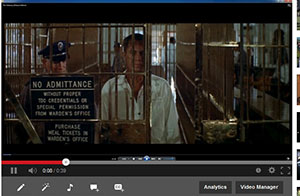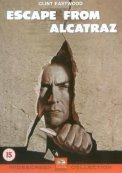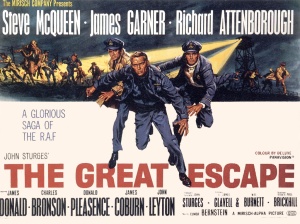The Great Muddy Escape, a prison-themed “fun run,” takes place this Saturday, October 26, 2013 and, with this in mind, Professor Mike Yawn spoke with various professionals associated with the prison system to discuss films involving prison life. Yawn spoke with Wayne Scott, Jim Willett, Rick Thaler, Richard Yawn, and Brian Olsen.
Wayne Scott began working for the prison system in 1971 and retired as Executive Director of the Texas Department of Criminal Justice in 2001. He continues to work within the industry as a consultant.
Mike Yawn: What’s your favorite prison film?
Wayne Scott: “The Shawshank Redemption.” To me, it’s the truest depiction of life behind bars for both inmates and staff.
MY: The film seems to fit the stereotype of the old-time state prison where the Warden had power that carried beyond the prison walls.
WS: I totally agree with that, Mike. One thing you learn from the film, particularly if you’re in that profession, is that if you put inmates in positions of trust, it’s generally fine, but when it goes bad, the consequences can be devastating.
MY: This topic of movies and prisons may be particularly well suited for you. If I recall correctly, you were in at least one movie that was filmed at a Huntsville prison. Was that you in a longshot walking up to the gates in the beginning of “The Getaway”?
WS: Yes.
MY: Did you meet Steve McQueen, Ben Johnson, or Sam Peckinpah?
WS: I met all of them. They were nice to the correctional officers and the inmates. Very nice people.
MY: Did you get to see the filming of “A Perfect World,” starring Clint Eastwood and Kevin Costner, when it was shot here?
WS; Yes and, in fact, we got to eat with the cast and crew there in the back lot down on the lower yard at the Huntsville Unit. I met both Eastwood and Costner. Another film, “Outlaw Blues” with Peter Fonda and Susan St. James, was also shot at the Walls in 1977.
MY: Why do you think these directors chose to shoot films in Huntsville?
WS: I think the Huntsville Unit is what most people think of as a traditional prison—the high brick walls, the architecture, the cells.
MY: Well, speaking of tradition, you began working for the prison under an older model, when inmates were in a position of trust within the walls. That changed with the Ruiz decision.
WS: Yes it did. The biggest operational changes involved the tremendous increase in staff. When you took those inmates out of trust positions, you had to backfill with staff, and we did that in the mid-1980s.
MY: You also witnessed the Fred Carrasco hostage situation at the Walls in 1974. Did you see any changes in the system after that?
WS: That’s another situation where an inmate was in a valued position there as a bookkeeper. He was able to get some freedom of movement that an inmate shouldn’t have had. That was tightened up after that event.
Jim Willett worked for TDCJ for 30 years, starting as a guard at the Walls Unit, working at Pack II, the Diagnostic Unit, and retiring in 2001 as Warden of the Walls Unit. He now serves as Director of the Texas Prison Museum.
Mike Yawn: What’s your favorite film that involves prison life?
Jim Willett: You know, Mike, it’s a toss-up between “The Shawshank Redemption” and “The Green Mile,” but I’d lean toward “The Green Mile.”
MY: Why is it your favorite?
JW: I thought that the film depicted what I actually saw in the prison system. The inmates were like the inmates I was around, and the correctional officers were like the correctional officers I was around. When I was there, most of the people in the system, whether in white or grey, were trying to do the right thing within the institution. Of course, you had some bad apples…
MY: You also mentioned “The Shawshank Redemption.” I don’t know if you realize that both “The Green Mile” and “The Shawshank Redemption” were novels written by Stephen King.
JW: I was not aware of that but, yes, I enjoyed “Shawshank,” some great acting in there, and also a movie that depicted what the system could be like.
MY: That film depicted an escape. How many serious escape attempts did you have while you worked for the prison?
JW: I guess about eight to ten. We had one at Pack II who got away and on a train. He wasn’t caught for several days, by which time he had made it to Trinity.
MY: But no one made it to a tropical island, like Andy Dufresne in “Shawshank?”
JW: Not during my time.
Rick Thaler began his career as a Correctional Officer in 1980 at the Walls Unit and progressed through the security ranks before retiring this year as the Director of the Correctional Institutions Division for TDCJ after 33 years. He has two degrees from Sam Houston and is now the Associate Director of Graduate Programs at the College of Business Administration at SHSU.
MY: What’s your favorite film involving a prison?
RT: For entertainment value, I’d go with “The Longest Yard.” Of course I am also a sports fan, so that adds value to the movie. For substantive value, I’d say “The Shawshank Redemption.” It was an entertaining and a realistic portrayal of that time in the evolution of prisons.
MY: “Shawshank” seems to be a lot of people’s favorite. What is so appealing about that film?
RT: I think the concept of never losing hope is important. Even in a prison, some of the characters in “Shawshank” were hopeful about the future. It’s important, wherever you are, to value life and maintain goals and aspirations.
MY: What’s the biggest misconception for people who don’t have up-close familiarity with the prison system?
RT: It may have been different long ago, but correctional systems are largely forward thinking in today’s society, and there are opportunities for individuals in our systems to turn their lives around. Violence within the institutions is rare. Our classification system separates the extremely abusive offenders from those who are actually trying to help themselves, and that’s different than earlier years in the correctional system. I’d say most of the films portray the older model of prison reality. That’s not to say we don’t have incidents today, but it’s more of the exception than the rule.
Richard Yawn worked for the Windham School District for more than thirty years, beginning as a teacher and retiring in 2005 as the Director for Operational Support. He currently works for Lee College, teaching American Government on various prison units.
Mike Yawn: What’s your favorite prison film?
Richard Yawn: Right now, I’d go with Clint Eastwood’s “Escape from Alcatraz,” which is about Frank Morris who, along with two others, escaped from Alcatraz in 1962. We were just in San Francisco this summer, so that helped nudge the film to the top.
MY: And did you go to Alcatraz Island?
RY: Yes, we toured it, and saw some of the movie locations.
MY: Do you think Morris got away?
RY: That’s one of the interesting aspects to the film. The ending is ambiguous and can be interpreted either way. In real life, you could think about it two ways, too. If they drowned, you would have thought a body or other remains would have been found. On the other hand, if they survived, you would think that one of the survivors would have given a death-bed confession.
MY: You mention Alcatraz, have you seen, “The Rock?” That movie also takes place on the island, albeit after it was no longer used as a prison.
RY: Yes, that’s with Sean Connery, Nicolas Cage, and Ed Harris. It was a fine action film, but I liked “Escape from Alcatraz” better.
MY: How about some other favorites?
RY: “Cool Hand Luke.” I liked Paul Newman in that.
MY: Do you happen to remember how many eggs he eats in the bet?
RY: The bet was whether he could 50 eggs, which he does. You kind of suffer along with him as he eats those.
MY: What else?
RY: Well, Steve McQueen was one of my favorite actors, and he was involved in several prison movies that I liked. “The Great Escape,” “The Getaway,” “Papillon,” and “Nevada Smith,” the latter being a film in which he actually commits a crime so that he can get into prison to exact revenge on one of the inmates. But out of all of those, I’d still have to go with Eastwood and “Escape from Alcatraz.”
Brian Olsen is the Executive Director of AFSCME, the Correctional Employees Council in Texas. He has been involved in the security field for more than thirty years and is a life-long movie fan.
Mike Yawn: What’s your favorite prison film?
Brian Olsen: “The Great Escape.” I was about eight years old when that came out. We had a little small-town theater on Main Street in West Des Moines, Iowa. It was mostly a poor railroad community, a bit rough, but we loved the old-fashioned theater that had a balcony. We’d go in there on a Saturday and, if we played things right, we could stay for more than one movie.
MY: Who’s your favorite actor from the great cast in “The Great Escape?” You’ve got Steve McQueen, James Garner, Charles Bronson, James Coburn, David McCallum.
BO: I like McQueen and Garner of course, but I also liked Richard Attenborough.
MY: Attenborough was an interesting character actor, but he was also a fine director. He did “Gandhi.”
BO: I think he was also in some of the “Jurassic Park” movies.
MY: What other prison films do you like?
BO: “Papillon,” with Steve McQueen and Dustin Hoffman, both of whom are imprisoned on Devil’s Island. McQueen’s character tries to escape nine times or so. He eventually gets out, but he has to endure a pretty horrible place. I also liked “Birdman of Alcatraz.” It stars Burt Lancaster, another of my favorites. He was in prison, and he adopted birds and other pets that gave him a reason for living. In the film, he gained the respect of the correctional officers, being compassionate and empathetic, adjectives that don’t typically come to mind when you think of inmates.
MY: Now, these movies you are mentioning are from the late 1950s and 1960s, which coincides with your childhood. What do you think it is about your childhood or that time period that made films so magical?
BO: I was a movie nut as a young kid. I went to the movies every Saturday, watching movies like “The Blob” or “The Curse of Frankenstein” or “The Great Escape.” Spielberg and Scorsese grew up then, too, and they were influenced by these films and it spurred them to make more magical movies. It was a Golden Age. You had movies like “To Kill a Mockingbird” or “Lawrence of Arabia.” I was a grubby little kid, a “little rascal,” but the movies were a chance to escape and to see what some consider great art. It was a good era in which to grow up, and it was a good era in my life.
For those who would like to participate in their own “prison escape,” the Great Muddy Escape offers a chance for a dash of fun while raising money for a good cause. Courses include a 5K, 2K, and a shorter “family run.” All include obstacles worthy of a prison escape. The Great Muddy Escape will be held Saturday, October 26, 2013. For more information, visit www.thegreatmuddyescape.com.












